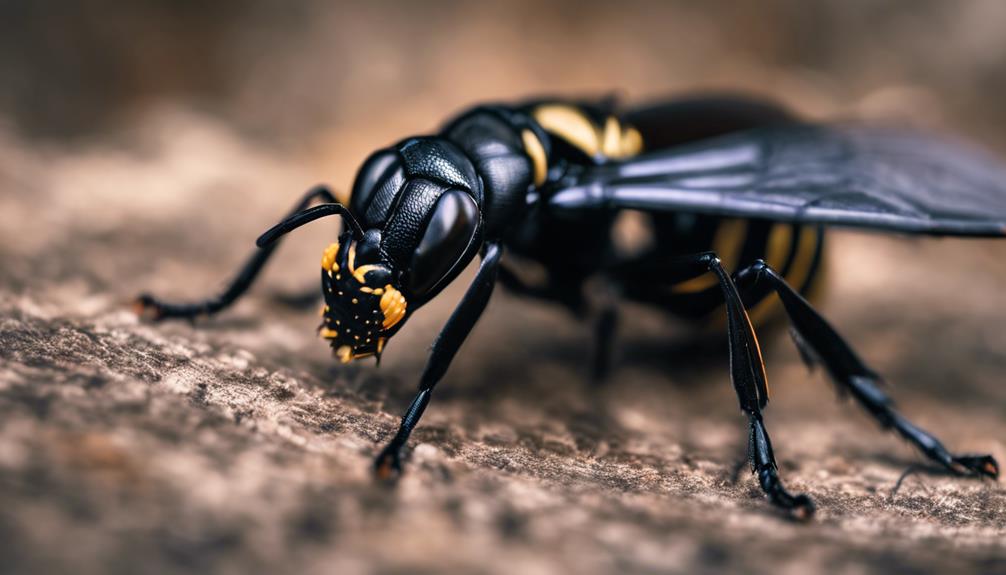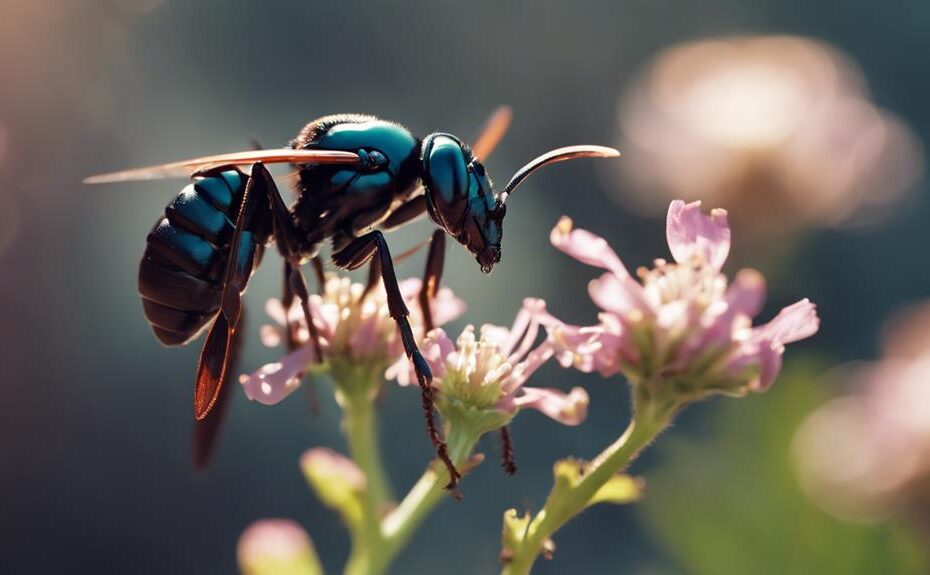The great black wasp, a creature often overlooked in the realm of insects, harbors a plethora of intriguing attributes that warrant closer examination. From its unique physical characteristics to its specialized hunting techniques, this wasp species displays a complexity that belies its humble appearance.
Moreover, its vital role in pollination and fascinating reproductive strategies add layers of mystery to this seemingly ordinary insect. As we unravel the enigmatic world of the great black wasp, we uncover a wealth of information that challenges our preconceived notions about these silent garden inhabitants.
Unique Physical Characteristics
The Great Black Wasp possesses distinctive physical characteristics that set it apart from other insect species, making it easily recognizable in its natural habitat. With a body size ranging from ½ to 1 inch in length, these wasps are relatively large compared to other species. Their sleek bodies are predominantly black, with some variations that include metallic blue or purplish iridescence on their wings. This color pattern aids in camouflaging them among the shadows of trees and shrubs where they are commonly found.
In addition to their size and coloration, Great Black Wasps have long, slender bodies with a constricted waist, giving them a sleek and agile appearance. Their wings are transparent with distinctive veins, allowing for efficient flight patterns essential for hunting and foraging. These physical attributes collectively contribute to the Great Black Wasp's unique presence in its ecosystems, where they play vital roles as predators and pollinators.
Impressive Nesting Behavior
What remarkable strategies does the Great Black Wasp employ in its nesting behavior that demonstrate its adaptability and survival skills? The Great Black Wasp exhibits fascinating nesting patterns and social behavior that contribute to its successful reproduction and colony development. Here are some intriguing aspects of its nesting behavior:
- Solitary Nesting: Unlike some other wasp species, the Great Black Wasp is a solitary insect that constructs individual nests rather than forming colonies. This strategy allows for reduced competition for resources and minimizes the risk of diseases spreading within a colony.
- Careful Foraging Habits: The wasp meticulously selects its prey, often targeting a specific type of insect to provision its nest. This selective foraging behavior ensures that the developing larvae receive a nutritious and appropriate diet, enhancing their chances of survival.
- Strategic Nest Placement: Great Black Wasps are known for their strategic nest placement, often selecting locations that provide shelter from the elements and predators. By choosing optimal nesting sites, the wasps increase the chances of their offspring reaching maturity successfully.
Specialized Hunting Techniques

Impressively, the Great Black Wasp exhibits specialized hunting techniques that are essential for its survival and reproductive success. One of the key strategies employed by the Great Black Wasp is its stealthy approach to prey. When hunting, the wasp demonstrates remarkable patience and precision, carefully stalking its target without alerting it to the impending danger. This stealthy behavior allows the wasp to get as close as possible to its prey before launching an attack, increasing the likelihood of a successful capture.
In addition to its stealthy approach, the Great Black Wasp is also known for its strategic ambushes. By strategically positioning itself in locations frequented by its preferred prey, such as beetles and katydids, the wasp maximizes its chances of a successful hunt. Once a suitable target is within reach, the wasp swiftly pounces, using its agility and speed to overpower the unsuspecting victim.
Vital Role in Pollination
Playing a crucial role in ecosystem biodiversity, the Great Black Wasp contributes significantly to pollination processes in its habitat. This species aids in transferring pollen from the male to the female reproductive organs of flowers, ensuring the production of seeds and fruits. The pollination benefits provided by the Great Black Wasp have far-reaching implications for the environment, influencing the abundance and diversity of plant species within its ecosystem.
Pollination Benefits of the Great Black Wasp:
- Efficient Pollinators: Great Black Wasps are known for their efficient pollination techniques, enhancing the reproductive success of various plant species.
- Diverse Plant Relationships: By visiting a wide range of flowering plants for nectar and pollen, these wasps establish crucial relationships that support plant reproduction.
- Ecosystem Resilience: The pollination activities of Great Black Wasps contribute to the overall resilience of the ecosystem, promoting stability and sustainability in the face of environmental changes.
The environmental impact of the Great Black Wasp's pollination activities underscores the importance of conserving and protecting these vital pollinators in their natural habitats.
Fascinating Reproductive Strategies

Demonstrating intricate mechanisms adapted for reproductive success, the Great Black Wasp exhibits fascinating strategies that contribute to the perpetuation of its species. This wasp species engages in multiple mating, a behavior seen in various insect species, which can increase genetic diversity within the population.
Female Great Black Wasps are known for their parasitic behavior towards other insects, particularly the katydids. They sting the katydids, paralyzing them but keeping them alive as a fresh food source for their developing larvae. This parasitic behavior ensures a readily available food supply for the wasp offspring, increasing their chances of survival and successful development.
Frequently Asked Questions
Do Great Black Wasps Have Any Predators or Natural Enemies?
Great black wasps face predation from birds like sparrows and blue jays, as well as certain insect predators such as spiders and mantises. Their natural defenses include powerful stings and agility in flight to evade threats.
How Long Do Great Black Wasps Typically Live?
Great black wasps typically live for a few weeks to a few months, with lifespan variations influenced by environmental factors like climate and food availability. Reproductive success and genetic diversity contribute to their survival in the ecosystem.
What Is the Average Size of a Great Black Wasp Colony?
Great black wasp colonies typically consist of a solitary queen overseeing a small number of offspring. Colony dynamics are characterized by the queen's reproductive success and nest architecture, with behavior patterns focused on foraging, mating, and nest-building.
How Do Great Black Wasps Communicate With Each Other?
Great black wasps communicate primarily through behavioral patterns and pheromones. They engage in intricate mating rituals and use specific movements and vibrations to convey messages to other members of the colony, enhancing their social interactions and coordination.
Are Great Black Wasps Beneficial to Humans in Any Way Besides Pollination?
Great black wasps are beneficial to humans besides pollination. They aid in pest control by preying on harmful insects like caterpillars, beetles, and grasshoppers. By maintaining ecosystem balance and serving as natural enemies to agricultural pests, they offer significant agricultural benefits.
Conclusion
In conclusion, black wasps play a crucial role in pollination with their specialized hunting techniques and fascinating reproductive strategies. They are essential for maintaining the balance of ecosystems and ensuring the survival of many plant species.
One interesting statistic to note is that a single black wasp can visit up to 1,000 flowers in a day, highlighting their efficiency as pollinators. Their unique physical characteristics and impressive nesting behavior further contribute to their significance in the natural world.

